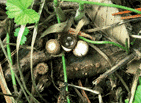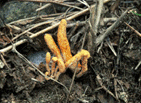- 글로벌메뉴
- KOREAN

 Korea Biodiversity Information System > Fungi/Lichen Resource > Fungi Classes > Collection and Specimens
Korea Biodiversity Information System > Fungi/Lichen Resource > Fungi Classes > Collection and Specimens
To collect mushrooms it is more practical to use easily available and simple tools rather than expensive and sophisticated ones. Different tools should be used depending on the habitat of the mushrooms to be collected.

Many species of Agaricales stretch their hyphae long into the ground; to collect them, use a shovel to dig soil from around the mushroom and brush the soil off to minimize damage to the rhizomorph.
When collecting wood-rotting fungi, since the mushroom is tightly bound to the tree, a knife, saw, hammer or scissors should be used to remove them. The tool used most often is a knife, and it is effective for removing the mushroom with part of the tree bark attached.
Another tool used often is a saw.
They are used when detaching the mushroom from the tree is difficult, and a generic hand saw is sufficient for this.
Pruning shears used by gardeners to trim trees can be used to collect mushrooms attached to smaller branches.
A wide basket with a handle and good ventilation is an adequate transportation tool for the collected mushrooms.
Great care should be taken in transporting soft and moist mushrooms, as they are likely to be broken and rotted.
Each collected item is placed in the basket in a separate paper bag, and very moist mushrooms may be put in plastic bags.
One bag should contain only one type of mushroom. When there are many specimens of the same type, it is possible to put them into several separate bags.
When you discover a mushroom, observe its macroscopic shape, color, and size, then observe its detailed structure with a magnifier, and measure its length with a portable ruler; recording as many vulnerable characteristics as possible in the field can provide great help for its correct identification.
The generation period of mushrooms is typically said to be early autumn, as mushrooms that appear in September and October are the greatest in diversity and quantity.
However, not all mushrooms occur in the fall, and the occurring types also differ depending on the season.
Mushrooms in Agaricales are annual ones that lose their fruit body after a season, but wood-rotting fungi are perennial or annual fungi that leave the form of their fruit body; therefore, several mushroom types can be found throughout the year.
The genesis and environment of a mushroom has a close relationship with the mushroom type, and it is important to specifically record the generation year, date, location and habitat.
In Korea, 64% of the land is composed of mountains, and is a very adequate environment to collect and research mushrooms. To collect mushrooms, it is desirable to start searching from adjacent places to wider areas.

Mushrooms, which differ from plants that synthesize nutrients by photosynthesis, grow well in shady and moist areas.
It is easy to find mushrooms in moldy leaves with abundant nutrients since they commonly live on dead plant organisms.
In particular, some wood-rotting fungi are parasitic to live trees, but most commonly proliferate on dead trees; it is easy to find them under dead tree trunks, stems, branches, and fallen branches. However, you don’t have to go to the mountains to discover mushrooms.
Mushrooms are unexpectedly close to us, and it is not uncommon to find mushrooms around houses, on the roadside, on lawns, in school grounds, in park forests, and on countryside farmland.
There are some mushrooms that demand special acknowledgement due to their unusual growth environment. For example, as Panaeolus papilionaceus has a life cycle that is accomplished through horse feces, it is required to investigate the feces to discover it.
Cordyceps militaris can be found only by collecting and observing dead insects.
Mushrooms collected in the wild should be preserved permanently after observation by making them into specimens.
Because Agaricales is a mushroom prone to decay, it is difficult to preserve in its original form. Therefore it should be made into specimen as soon as possible. The two methods to make mushroom specimens are dry specimen and immersion specimen.
In general, dry specimens are usually made because of their simplicity and convenience in arrangement and preservation.
For mushrooms with a harder and more easily maintained shape, it is possible to make an appropriate specimen by drying them indoors for four or five days.
However, Agaricales prone to decay can be made into specimens by drying them with hot air at 50-60℃ for several days.
Most mushrooms change in shape, size and color through the contraction of their fruit body by dehydration during drying, and it is advisable to record as many characteristics of the living organism as possible by taking pictures of it before drying it.
After drying, the mushroom becomes crispy and is prone to breaking. Thus, it is recommended to leave the specimen in the air for several hours to soften it through the absorption of moisture in the air for easy handling.
Completely dried mushrooms can be stored in a specimen box within a specimen bag.
It is common to write the specimen number, classification number, scientific name, Korean name, collection site, habitat, host, collection date, collector, identifier, and special characteristics on the surface of the specimen bag.
You should be careful to protect the mushroom specimen from generating bugs or fungi during storage.
In order to prevent the occurrence of fungi, it is recommended to remove moisture by operating a dehumidifier in the storage room or by placing a dehumidifying agent in the specimen bag or the specimen box.
In order to prevent invasion of bugs, it is required to place insecticides such as a moth balls with the specimen.